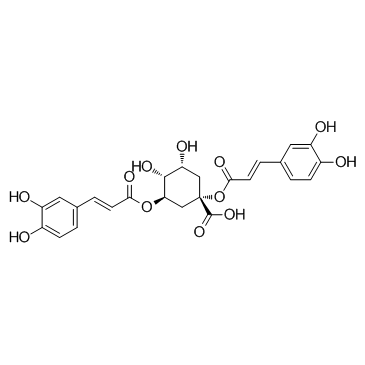19870-46-3
| Name | (1S,3R,4R,5R)-1,3-bis[[(E)-3-(3,4-dihydroxyphenyl)prop-2-enoyl]oxy]-4,5-dihydroxycyclohexane-1-carboxylic acid |
|---|---|
| Synonyms |
(1S,3R,4R,5R)-1,3-Bis{[(2E)-3-(3,4-dihydroxyphenyl)-2-propenoyl]oxy}-4,5-dihydroxycyclohexanecarboxylic acid
1,5-Dicaffeoylquinic acid 1,3-Dicaffeoylquinic acid Cynarine 1,5-di-O-Caffeoylquinic acid 1,3-O-Dicaffeoylquinic acid (1S,3R,4R,5R)-1,3-Bis{[(2E)-3-(3,4-dihydroxyphenyl)prop-2-enoyl]oxy}-4,5-dihydroxycyclohexanecarboxylic acid Cyclohexanecarboxylic acid, 1,3-bis[[(2E)-3-(3,4-dihydroxyphenyl)-1-oxo-2-propen-1-yl]oxy]-4,5-dihydroxy-, (1S,3R,4R,5R)- 1,3-di-O-Caffeoylquinic acid |
| Description | 1,3-Dicaffeoylquinic acid is a caffeoylquinic acid derivative that exhibits antioxidant activity and radical scavenging activity. |
|---|---|
| Related Catalog | |
| Target |
Akt PI3K |
| In Vitro | 1,3-Dicaffeoylquinic acid shows increased neuronal cell viability against Aβ(42) toxicity in a concentration-dependent manner in neurons. 1,3-Dicaffeoylquinic acid activates both phosphoinositide 3-kinase (PI3K)/Akt and extracellular regulated protein kinase 1/2 (Erk1/2) with stimulating their upstream tyrosine kinase A (Trk A). 1,3-Dicaffeoylquinic acid's anti-apoptotic potential is related to the enhanced inactivating phosphorylation of glycogen synthase kinase 3β (GSK3β) and the modulation of expression of apoptosis-related protein Bcl-2/Bax[2]. 1,3-Dicaffeoylquinic acid (10 μM, 20 μM, 50 μM, and 100 μM) significantly increases cell viablity before OGD/reperfusion, and prevents the depletion of GSH under OGD/reperfusion insult. 1,3-Dicaffeoylquinic acid induces nuclear translocation of Nrf2 in OGD/reperfusion treated astrocytes, and induces increased GCL activity, and the effect is lost in Nrf2 siRNA-transfected cells[3]. |
| In Vivo | 1,3-Dicaffeoylquinic acid (32.0 mg/kg, p.o.) and 1-O-ABL are absorbed very quickly in Wistar rats. The maximum plasma concentrations for 1,3-Dicaffeoylquinic acid and 1-O-ABL are 44.5 ± 7.1 and 19.1 ± 6.9 ng/mL, respectively[1]. |
| Kinase Assay | The whole cellular lysate is prepared using a RIPA Lysis Buffer added to a reaction buffer containing 0.1 M Tris (pH 8.2), 0.15 M KCl, 10 mM ATP, 10 mM l-glutamate, 20 mM MgCl2, and 2 mM EDTA at 37°C for 3 min, and then 5 mM cysteine is added at 37°C for 15 min. The production of glutamylcysteine is immediately quantified for HPLC analysis by O-phthalaldehyde derivatization. GCL activity is presented in units of femtomoles of -GC produced per milligram of protein per minute[3]. |
| Cell Assay | The viability of astrocytes is measured by the MTT reduction method. Briefly, the cells are rinsed with phosphate-buffered saline, pH 7.2, and incubated with 5 mg/mL MTT reagent for 3 h at 37°C. The medium is removed, and the cells are lysed with 1 mL of dimethyl sulfoxide. The absorbance is measured at 540 nm by a microplate reader[3]. |
| Animal Admin | Six male Wistar rats (200-250 g) are fasted for 12 h with free access to water prior to oral administration of I. britannica extract with an herb dose of 8.0 g/kg (equivalent to 32.0 mg/kg 1,3-Dicaffeoylquinic acid, and 4.01 mg/kg, 1-O-ABL). Blood samples (appr 0.25 mL) are collected from suborbital vein into heparinized tubes at 0, 0.08, 0.16, 0.33, 0.67, 1, 1.5, 2, 4, 6, 9 and 12 h after dosing, and then immediately centrifuged at 3500 rpm for 10 min. Harvested plasma samples are stored at -60°C until analysis. The plasma concentrations of 1,3-Dicaffeoylquinic acid and 1-O-ABL are calculated from the calibration curves obtained daily[1]. |
| References |
| Density | 1.6±0.1 g/cm3 |
|---|---|
| Boiling Point | 819.9±65.0 °C at 760 mmHg |
| Molecular Formula | C25H24O12 |
| Molecular Weight | 516.451 |
| Flash Point | 278.1±27.8 °C |
| Exact Mass | 516.126770 |
| PSA | 211.28000 |
| LogP | 1.64 |
| Appearance | white to off-white |
| Vapour Pressure | 0.0±3.1 mmHg at 25°C |
| Index of Refraction | 1.719 |
| Storage condition | 2-8°C |
| Water Solubility | soluble5mg/mL, clear, colorless to light yellow |
| RIDADR | NONH for all modes of transport |
|---|
